A week in and out the shop
Published 2 Mar 2020
Tags: antoria, guitar shows, pyrography, squire bass iv, stratocaster, workbench
Let’s get the exciting/terrifying news out the way first: Electric Flapjack will be exhibiting at the Newmarket Guitar Show on March 29th! If you’re in the area, then please do come by and offer some moral support :)
I’m totally not ready for this guitar show, but I have to start doing them at some point as a way of reaching out to more people, and this one is practically on my doorstep, so if I don’t do this now, it’ll be another year before I get such a simple way to dip my toe in the waters, and anywhere else will require lots of travel and an overnight stay, so it’s also considerably cheaper in actual cost, not just opportunity cost.
Looking at the exhibitor list (which I’m glad I didn’t look at before I signed up), there’s no way I can compete on the stock guitars I have with the beautiful and unique guitars that will be on display from the more established UK builders like Stone Wolf Guitars and Crimson Guitars, so I think I’ll try taking a different angle and run a stand similar to the Makefest stand where I show parts of guitar in progress, and with one or two finished guitars and treat it very much as a bespoke build where you have close contact with the builder. I can also try touch on some of the novel bits like how I wrote the code that lets me laser etch the fret locations etc.
I do have a couple of stock guitars, but I’m aware that even they are a couple of builds old now, and don’t represent the best of what I can do today, but without a workshop right now, it is what it is and these are the guitars I’ll have to go with. I’m going to be feeling a bit like a child trying to show the grown ups what he’s made and hoping no one is going to point and laugh too much :)
Thus, if you’re free on Saturday March 29th and are in the Newmarket area then please do stop by and say hello :) Tickets for the show are only £5, and beyond me the exhibitor list really does have some good names on it, so it promises to be a good show.
As I mentioned last week, my workbench is still not expected until later this coming week, so I’ve not made any dust for what feels like far too long a time.
I did however pick up some new old hand-planes for my future workspace this week. The father of a Makespace member recently passed away, leaving behind a large collection of woodworking tools. They all need a bit of fettling, but they were all good stuff - proper old Stanley and Record planes for instance. I along to see the collection with fellow Makespace workshop member Chris, as the Makespace member had asked if the Makespace workshop would like any tools as a donation, and there were enough good tools there that not only did we get a good set for Makespace, I bought a few planes for myself too. They’ll all a bit rusty, but definitely in the state that with a bit of a polish they’ll be fine tools again.
Obviously events like this are very unfortunate, but I hope it helps to know that all the tools we took for Makespace and those I bought will be put back into good use.
I did spend a little time working on other people’s guitars this week. I was determined to finish this Squire Bass VI to a point where I felt it was playable. This week it was just getting the electronics to work properly, which given all the other efforts I’d had to put into this guitar turned out to be a lot easier than I’d feared.
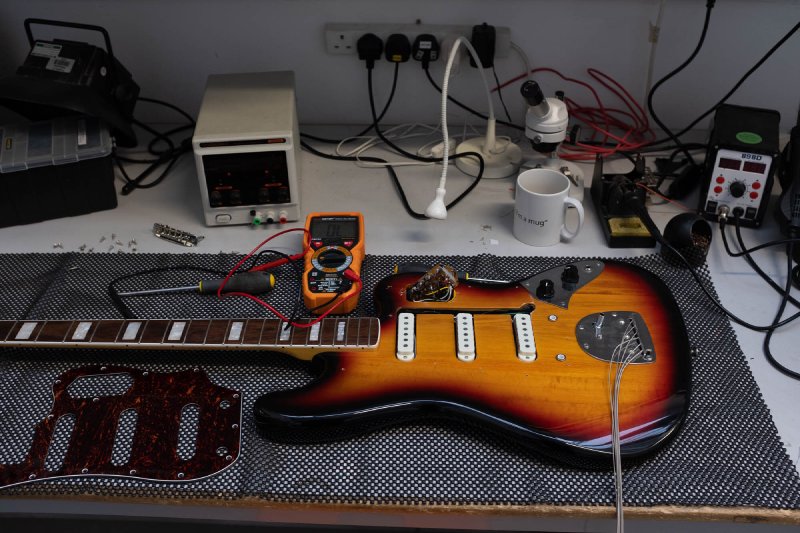
First up was the neck pickup wasn’t selectable, and that turned out to just be the selector switch itself was broken. Thankfully the switches they use connect a middle terminal to either a left or a right terminal, and they only use one side of that, so I was able to unsolder the switch, physically swap it around the other way, and solder onto the second connector and then everything was good again. I’m always in preference of preserving original parts if I can, so this to me was a double win: working and with the original switch.
Next up I turned my attention to the volume and tone control, which made large amounts of noise when you touched them, as did in fact anything metal on the guitar. I’d assumed incorrectly that I’d need new pots, but it turned out that someone had messed with the electrics at some point and just got it wrong.
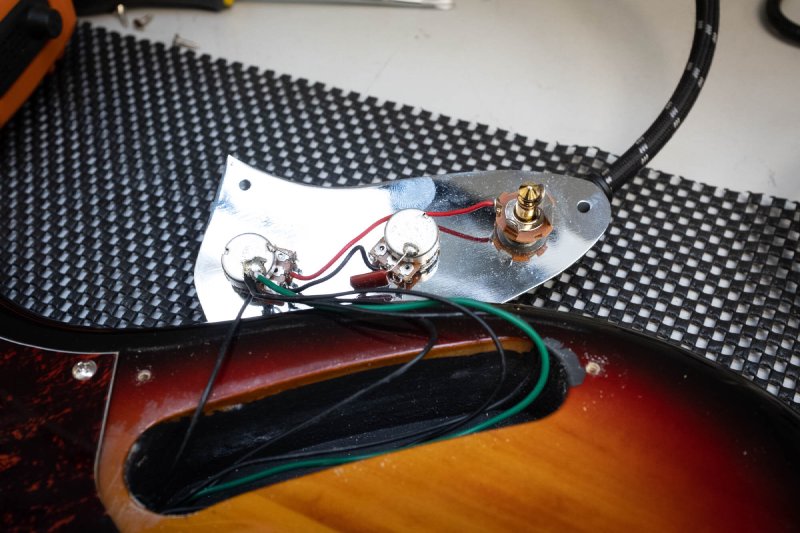
You could see at some point the way the tone capacitor was wired up wasn’t standard, and I assume it was at this point they tried to be clever and use the metal control plate as a common ground for the output jack and volume and tone potentiometers. Unfortunately that just doesn’t work with chromed parts: you can’t get a reliable electrical connection over them, even though they look shiny and metallic. So all that was needed here was to put in a new set of ground connections across all three parts and voila, all the noise was gone. Again, I was able to keep the original parts too.
I guess the moral here is always start with the simple stuff before you start ripping things out and replacing them. A bit of time spent here with a multi-meter let me trace all the issues back to simple root causes with simple solutions. It probably took me almost as long as replacing all the pots etc., but is a lot less wasteful and keeps the original guitar more intact, which I generally prefer.
With the electronics fixed, all that was left was to replace the missing strap button, and this was done. What a job this guitar was, certainly my most involved setup job to date. Here’s a full list of what I had to fettle on it:
- Adjusted the truss-rod to get the neck straighter as part of bringing the action down.
- Set up the bridge saddle unit to the proper height, as before the saddle themselves had been set to a crazy angle as it’s not at all obvious you can adjust the height of the entire unit.
- 3D printed some shims to stop the bridge plate the saddles sit on to stop it rocking back and forth.
- Cut the nut so the strings actually sit in rather than over the slots.
- Set up the saddles with the correct height for the fretboard radius and at the correct position to get the intonation correct (or as close as I can get in the circumstances). This involved removing a spring from the saddle for the low E just to get it back far enough.
- Removed and put back the switch for the neck pickup selector.
- Fixed the common ground for the electronics.
- Put a new set of strap buttons on there as one was missing when it came in.
- Cleaned and re-oiled the fretboard.
- Put on a fresh set of strings.
Phew!
If I’m honest, I’m still not entirely happy with how it plays: the action on the low-E is still a bit too high for me, but without more radical action I don’t think there’s much I can do about that on this particular guitar given where the neck is at. That said, I can hand-on-heart say it plays a million times better now than it did when I first got it, so I’m pleased with where we got to overall.
It’s certainly been educational: as I said when the guitar first came in I have a bit of a soft spot for the Bass VI, as it tries to be something new. Whilst I am a bit disappointed now I’ve met one in the flesh, I still fancy trying to make a similar cross over instrument at some point and that will be all the better for having put in the time and effort trying to maintain his one.
Just as the Bass VI goes away, in comes another guitar: an Antoria strat clone that a friend of mine had squirreled away:
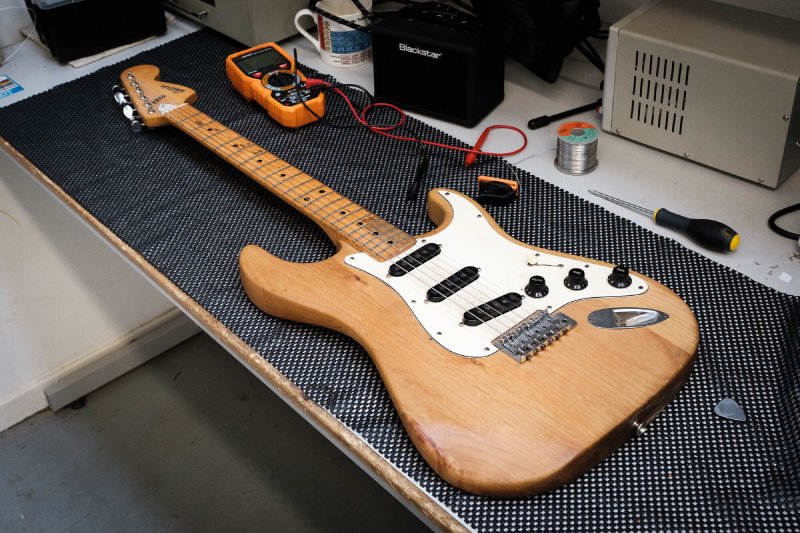
I’d not heard of the brand Antoria before, but apparently they were a popular and well regarded Japanese built range of guitars in the 60s and 70s: Hank Marvin apparently had an Antoria strat before he got the real thing (as a quick aside, I was lucky enough to see Hank Marvin play at a concert in the late 90s, and I’m still very grateful to the parents of my friend who took me along :).
This guitar has had quite a life by the looks of it: the neck shows someone shredded on this a lot (all the wear at the body end of the neck), and the body itself has been apparently stripped and oiled for the natural look. It looks quite beat up, but I quite like the well loved guitar look, so I like this. I tried to date it from the serial number, and one account suggested that the guitar and I were born in the same month of the same year - though I’d take that with a very large pinch of salt given how little information is around for these guitars.
Anyway, the main issue with it, and why my friend asked me to take a look at it, was the electronics were unusable - you touch any of the controls and the guitar starts to cut out, crackles etc. Unfortunately, unlike the Bass VI, it does have a good working common ground, so either the soldering is shot in places, or the components are dying off. I did a quick initial check of the insiders:
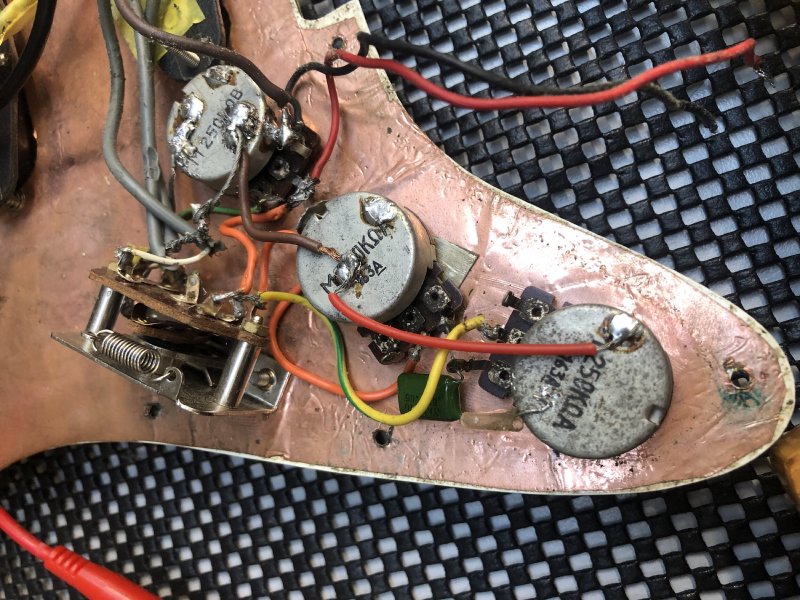
From this I did establish the grounding is all good, that the pickups are okay (in that they offer a resistance in the expected range), and so I think my next step is to remove all the terrible solder work and just start wiring things up afresh and seeing what does and doesn’t work component wise.
A few weeks ago I mentioned that I met Luke, who has been doing some guitar based pyrography at Makespace, and I asked him to make me a few samples so I could try seeing how they reacted with my staining and oiling process. I was particularly concerned with this as I know from trying to laser etch it that swamp ash burns really easily, and I was worried it’d just burn too easily. But certainly Luke’s done an awesome job on these samples:
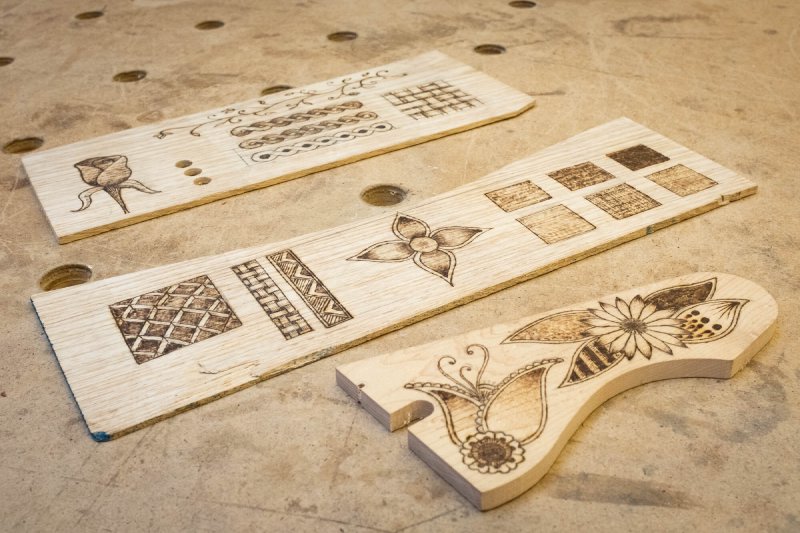
So now I have these I’ll apply my finishing to them and see how they look afterwards. I might even try doing some staining with a paint brush to see whether the pyrography burns the fibres enough to stop the natural capillary action that would otherwise cause the stain to leach out of the areas where you apply it (something I’ve had success with on laser etched lines in the past).